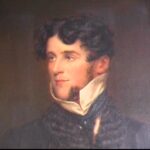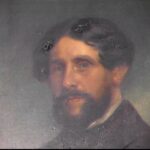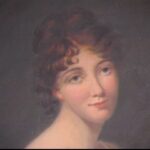Barely ever visited Mourne Park, although his wife, Jane Gun Cunninghame, along with trustees appointed by the Earl, made some major alterations to the parkland.
Inherited the Earldom in 1832
Complicated romantic attachments, and a passion for property development
Francis Jack Needham, known as “Black Jack”
Our Great Great Great Great Grandfather
Born 1787
Died 1880







Notable Moment
1822, as part of a wager, he rowed with 5 of his servants from Oxford to Westminster bridge in London in 14 hours. It is said that he had his men posted at all the locks on the Thames to make sure that they were ready for him, and he had to be carried senseless out of his boat at the end
The 3rd Earl held various roles, including MP and Aide de Camp to Edward VII. He chaired the first meeting in 1883 to propose building the lock and tide barrage at Richmond. However, he is most memorable for his love of putting on events and for his wife.
When at Oxford he organised balls, one of which may have contributed to the rupture between Charles Dodgson (better known as Lewis Carroll) and the Mrs Liddell, the mother of Alice (for whom ‘Alice’s Adventures in Wonderland’ was written). Later, Francis was a theatre impresario, he wrote (Ecarte). He clearly inherited his grandfather’s generosity. The play included a picnic scene, he organised a real hamper, with unlimited champagne as a prop. The play had to be abandoned as the cast, under the influence of the drink, had variously fallen asleep or started to engage in belligerent conversation with the audience.
Kilmorey married a notable beauty, Ellen Constance. She is rumoured to have been a lover of Edward VII and to have occupied a seat in the ‘Royal Loose Box’ during his coronation (the seats in Westminster Abbey reserved for his previous mistresses and lady friends). She was certainly the mistress of Prince Francis of Teck, the brother of Queen Mary (wife of George V). When he died in 1910 he left the fabulous Cambridge emeralds (part of the Teck family jewels) to her. This was a scandal, as the emeralds were considered part of the royal jewel collection. Queen Mary intervened to persuade Ellen to return the emeralds to the Royal family (possibly in return for a large sum of money). Prince Francis’ will was ‘sealed’ so it would not become public. This is now a firmly established tradition, every subsequent Royal will has been sealed. The Cambridge emeralds have been sent in some of the most magnificent jewellery that continues to be worn by members of the Royal family.
(Andrew George, see below)
The first Earl was succeeded by his son, known by his family as the Wicked Earl, but called elsewhere “Black Jack” Kilmorey. He was a regency buck, who had apparently already fathered at least one child before he married, in 1815 at the age of 27. His bride was Jane Gun Cunninghame. She is known as the “Unhappy Lady Kilmorey”, because of his unkind treatment of her. In the next five years she bore him three sons and a daughter, after which he appears largely to have ignored her. He was extremely rich, owning 55,000 acres of which 43 acres were in Isleworth, besides the Thames. His hobbies seem to have included building and altering houses. Apart from his town house, in Grosvenor Place, he also occupied or built no fewer than five large houses in Isleworth. In the 1830s he resided mostly at Shavington, but left it “to go to rack and ruin” in 1839 . Later a cousin, Owen Grant and his sister lived there, and administered the estate well.. By repute his wife was left in Ireland, where an overgrown path down the glen is known as Unhappy Lady Kilmorey’s path. She is supposed to have walked up and down it, bewailing her fate.
(text extract taken from A Short History of Mourne Park, Julie Ann Anley, October 1999)
His friend Captain William Hoste died in 1828, leaving his six young children as Lord Kilmorey’s wards. By 1840 the Wicked Earl had formed an attachment with 17-year-old Priscilla Hoste, the youngest daughter. They eloped. Their son Charles was born in 1844, and sent to Eton at the same time as his legitimate grandchildren; a great embarrassment to them. Priscilla died in1854. Stricken with grief, he built a magnificent mausoleum to hold her remains (which was dismantled and rebuilt twice, when he moved house.)
At Mourne Park the estate was administered locally by an agent; nonetheless, the decision to bring relief to the miseries of the famine by enclosing the demesne in a wall is generally attributed to the Earl himself. The Mourne Mountains are granite, and Mourne men are famous for their ability to work the stone. (Many of the kerb stones and monuments around Kensington bear witness to the skills of Mourne masons). So Mourne Park ended up with one of the finest Famine Walls in Ireland.
At the same time he declared that he was enclosing the old Rostrevor high road within the park, “because he liked the Old Bridge”. A new bridge had to be constructed outside the walls, more suitable for the volume of traffic. Thus the Old Bridge was preserved for posterity.
Meanwhile his son, Viscount Newry and Morne, had died in 1851, aged only 36, leaving three sons and three daughters. The eldest grandson thus became his heir, who anticipated the imminent demise of his grandfather.
The 2nd Earl of Kilmorey
Jack Needham, 2nd Earl of Kilmorey (pronounced Kilmurray).
Often known as ‘Black Jack’ his colourful life has attracted so many stories and anecdotes that it can be difficult to tell truth from fiction! For example, it is said that he was a member of the notorious Hellfire Club founded by Sir Francis Dashwood, whose rituals involved sex, drinking and feasting. This is unlikely as the club ceased to meet well before Needham was born, though it is possible that he was a member of one of the Hellfire Clubs that continued in Ireland.
Jack Needham was born in 1787 and educated at Eton. It is said that he ran away from the school to join Wellington’s army in the Peninsular. He became an Ensign in the army, and an MP for Newry. The family had extensive estates in Newry, as well as land in Shropshire and Cheshire. He travelled widely and bought hotels in Switzerland and Canada.
In 1814 he married Jane Gunn-Cunninghame. They went on to have four children. He inherited the Earldom from his father in 1832.
He was an athletic man. In 1822 (as part of a wager) he rowed with 5 of his servants from Oxford to Westminster bridge in London in 14 hours. It is said that he had his men posted at all the locks on the Thames to make sure that they were ready for him, and he had to be carried senseless out of his boat at the end. Rowing was important for him. He was a supporter of Harry Clasper the pioneering rower from Tyneside whose made major contributions to the development of rowing both as a sportsman and a designer of boats.
So far, the story is a rather conventional one of a young aristocrat with plenty of money and energy. However, his personal life became rather more colourful in mid-life. He was a close friend of Captain Sir William Hoste Bt KCB KMT. Hoste was one of Nelson’s captains, commanding frigates in the Mediterranean. In the Napoleonic Wars the frigate captains were the glamorous buccaneering heroes of the nation. Hoste is said to have sunk or captured more than 200 enemy ships (though one has guard against hyperbole!), as well as winning the battle of Lissa (1811) against a much larger combined French and Venetian force (this battle is of note as the French commander unsuccessfuly used the same tactics that Nelson had used in 1805 in Trafalgar and, like Nelson, was killed during the fight.). Hoste was an aggressive and successful leader, capturing of Spalato (now Split) and Ragusa (now Dubrovnik).
The Captain was knighted, created a baronet and married Lady Harriet Walpole. Jack Needham became a close friend and when, in 1828, William Hoste died Needham became guardian of his 6 children.
In 1843 the Earl eloped to France with the youngest daughter, Priscilla. She was 20 at the time, he 56. Her brothers set of in an unsuccessful pursuit. The next year the couple returned to England to live in Cross Deep, Twickenham, where their son, Charles Needham, was born.
They continued to live in the region, variously inhabiting Radnor House, Cross Deep House, Orleans House before purchasing St Margarets and Gordon House. Kilmorey seems to have loved buying houses, doing them up, adding parcels of land and then moving on. He enjoyed labouring with his own hands, building walls and digging grounds.
In 1851 he bought Gordon House and St Margarets House, which he demolished and built a grand house for him and Priscilla to live in. It was designed by Lewis Vulliamy and cost £16,920 (£2.4m today). It was a grand building in a classical style, with a sumptuous interior. What will astonish many who have done even minor extension works on their own property, the house was completed by July 1852, the year after the original purchase.
Unfortunately, Priscilla and Jack were never to live in this house. In 1851 she fell ill with heart difficulties. It was clear that she was going to die. In 1853 he applied to build a large mausoleum in the Brompton Cemetery. Due to its size he required permission from both Palmerston (then Home Secretary) and Gladstone (Chancellor of the Exchequer). The tomb was designed by Henry Kendall Sr in an Egyptian style. Priscilla died on the 21 October 1854 and was laid to rest in the mausoleum. This was in a prominent position in the cemetery, at the intersection of several avenues.
The mausoleum is made of polished grey and pink granite, designed like the shrine in an Egyptian temple. Its sides are 15 feet long, and it is set in an octagonal base 47 feet in diameter. It is carved with Egyptian inspired imagery, some of which is a good imitation of the original. However, some is more in the ‘spirit’ of Egyptian art, for example the lotuses on either side of the door to my eyes have something of the thistle in them. The stars are also shaped differently from how ancient Egyptians would have carved them. There are massive bronze doors with a concealed lock on one side. One the other sides are false doors carved into the granite.
The interior of the mausoleum is lit through star shaped holes in the roof, covered in yellow glass. There are two red leather-bound coffins rest on either side of the door, the one on the right carrying the inscription, “Priscilla, the beloved of Francis Jack Earl of Kilmorey born 26th June 1823 died 21st October 1854” and the other simply stating “Francis Jack. Second Earl of Kilmorey born 13th December 1787 died 20th June 1880”.
On the back wall is a fine marble relief showing Priscilla lying on a bed, with a grieving Earl at her feed and her son, Charles, at the head. At the top there is an angel flying in a slightly improbably manner above the dying Priscilla, pointing out the direction she needs to take to get to heaven. This was done by Lawrence Macdonald, a noted sculptor who lived in Rome. Kilmorey took Charles with him to Rome after the death of his mother, and the carving may have been done then. Macdonald carved a full-length statue of Kilmorey as Ulysses with his dog, which was exhibited at the Paris Great Exhibition of 1855. It is now in the grounds of Mourne Park, the Kilmorey house in Newry.
The Egyptian design of the mausoleum was not uncommon in those days, though there were few of the quality and size of the Earl’s. Kilmorey was influenced in his design by Joseph Bonomi an Egyptologist and fellow believer in the occult. It has been suggested that Bonomi and Kilmorey thought that the mausoleum could act as a time machine, transporting those inside through time and space. Bonomi also helped design of the Egyptian style mausoleum for Hannah Courtoy and two of her daughters in Brompton Cemetery, completed in 1853, which is similar to the Kilmorey mausoleum, though simpler. The Courtoy mausoleum is thought by some to have been built as a time machine. Even more fancifully it has been suggested that Bonomi and his associates were trying to build teleportation chambers in seven London cemeteries to aid rapid transportation around the capital. One of his collaborators was Samuel Warner, who invented a ‘physic torpedo’ to teleport explosive bombs short distances. He even persuaded the Royal Navy to trial the device, with limited success.
Who believed what, and who was fooling whom, is now impossible to tell (unless we can find a modern TARDIS that will transport us in time and space to the 1850s!). However, as will become evident later Kilmorey probably did believe that the mausoleum had occult properties, linked to Egyptian mythology.
| Written by: | Andrew George |
| © | The copyright to this section belongs to Andrew George. Please see the video clip below of Andrew speaking about the Second Earl on February 14th 2022 |
He did not stint on cost, it cost £30 000 to build plus another£1 030 16s 9d for the site. There is evidence from a letter he wrote at this time that he was feeling short of money, and this may be why the Earl sold St Margarets House and the estate to the Conservative Land Society in 1854. They sold the building and land immediately around it in 1856 to the Royal Naval Female School. In the same year the Earl who had been living in Gordon House, rented it out and moved to Sunbury. In 1862 he moved to Woburn Park near Weybridge. He moved the mausoleum out of the Brompton Cemetery into the grounds of his house.
The Earl had separated from Jane his wife in 1835, prior to his elopement. In the legal agreement for the separation, he agreed to a generous financial annuity of £2000 (about £180,000 now), and not to enforce his rights of coverture (his authority over her as her husband) or his conjugal rights. The Countess died on the 15th July, 1867 in Putney and was buried in Datchet (where his sisters lived). A few months later (20th November), the Earl married for a second time, to Martha Foster. He was 22 days short of his 80th birthday. We do not know how old she was, but as she lived until 1908 one might surmise that she was somewhat younger than him.
The next year they returned to Gordon House, moving the mausoleum with them to its current site, diagonally opposite the Ailsa Tavern. Kilmorey clearly retained his devotion to Priscilla, he is said to have dressed in a white shift and got his servants to wheel him through a tunnel to the mausoleum where he would lie beside Priscilla’s coffin. He may have been trying to recreate the journey of the sun god, Ra, journey from darkness to light, from death to life. This story seemed an improbably myth made up about the Earl until, in 1966, a tunnel was discovered under Kilmorey Road. It had paths sloping into it at each end and was painted with a green trellis design. The Earl seems to have been associated with tunnels, in Sunbury he built a tunnel under the road to a boat house. In other accounts he is said to have housed his wife and mistress in adjoining houses with a tunnel between them. This is one of those rare times when reality seems more improbable than the myth – the lover was dead, and her house was a mausoleum!
One can only speculate as to what Martha made of this. It is not often a wife has to share her husband’s affections with his dead lover. The Earl of Kilmorey is such a larger than life character that he throws a shadow over those who surround him, and we know remarkably little about Jane, Priscilla and Martha. He was devoted to Priscilla, and clearly loved their son, Charles.
At some stage he fell out with his family. This was in part because of disapproval of his romantic attachments, and there appears to have been a disagreement on how both the Newry and Shropshire estates were run.
The Earl was a man of particular habits. Even as an old man he liked to spend much of the time outdoors, in all weathers. He was a kind employer, every year he would take all his staff to the Alhambra Theatre in London. One year they missed the train home and walked all the way, arriving in Gordon House in the early hours. He was recognised for his generosity to the residents of Isleworth and Twickenham.
He kept himself fit, doing gymnastics in his bedroom, and was abstemious, weighing his food and being moderate in his alcohol consumption.
He is described as having ‘strong fancies’ in dress. He is described as coming to down to dinner in a blue coat with brass buttons and bright crimson trousers. For a while he did not wear socks or stockings. His pictures, the statue and the descriptions of him suggest a handsome, muscled, vigorous man with ‘..an open collar, showing a well formed neck, enlivened rather than confined by a loose bright coloured tie, a vast expanse of shite shirt, well suited to exhibit a magnificent chest…’
In the last years of his life he was looked after by Maria, a short square Irish maidservant about 4 foot six tall. Perhaps as his vitality waned with age, Maria is a woman who starts to emerge from his shadow. She looked after his needs, as a ‘valet, chambermaid and cook’, and seems to have given as good as she got in repartee with the Earl.
Jack Needham died in 1880 at the age of 93. The local priest was unsure whether he should be afforded a Christian burial, but his scruples were overcome when someone discovered a prayer of penitence that he wrote was discovered. He was laid to rest beside Priscilla in the mausoleum he had built more than a quarter of a century previously.
His ancestors in their different ways continued to have interesting lives. Charles Needham, his illegitimate son, married a rich Dutch heiress, Henriette Amélie Charlotte Vincentia barones van Tuyll van Serooskerken (more concisely known as Amy) and joined the 1st Life Guards. He was also for a time a professional gambler, with the inevitable financial ups and downs. His daughter, Violet Needham, was a well-known 20th century children’s author. The chapel that is now part of the Rambert School of Ballet and Contemporary Dance is named after her.
The 2nd Earl’s son had died, and so the title was inherited by his grandson, Francis Needham. He was born 2 years before Charles. The relationship between the two men was close enough, in spite of the scandal of Charles’ birth, that the 3rd Earl was godfather to Violet Needham.












